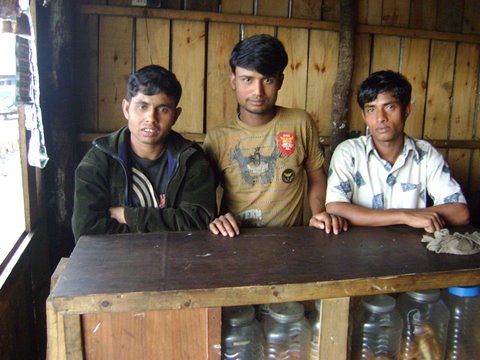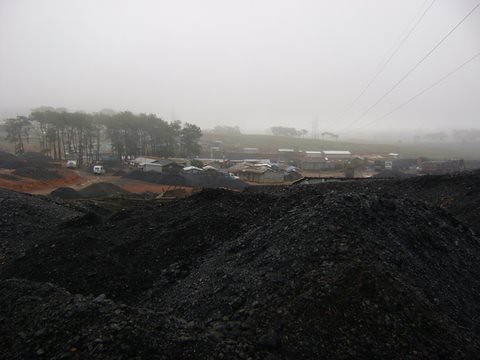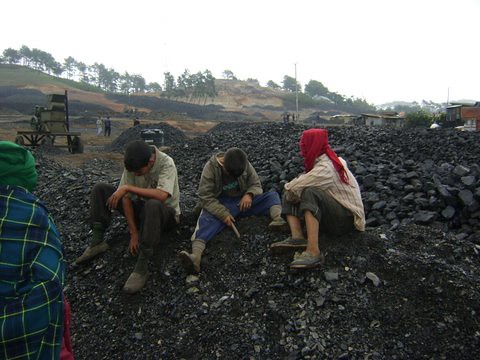Coal mining in Meghalaya: Child labourers in the ‘rat-holes
Coal mining in Meghalaya: Child labourers in the ‘rat-holes’
Submitted by admin4 on 14 October 2010 - 5:32pm
By Anjuman Ara Begum, TwoCircles.net,
“Inside the mine everything is very fragile. Even the falling of a small rock can cause death sometimes. People from outside cannot imagine what the hell is inside the mine!” These are the words of 16-year old Muzzammal Haque who works in a coal mine in the Jaintia Hills, Meghalaya. He is yet another example of the bonded child labour in the various coal mines in the Jaintia Hills on which the National Human Rights Commission has asked the government of Meghalaya to submit a report.
The National Human Rights Commission acted suo motu based on several media reports and registered a case – Case No. 22/15/3/2010. After two days of issuance of the NHRC’s notice, the Jaintia Hills district authorities in Meghalaya found on September 8 that 222 children were working in the coal mines. The Government reported that the children were from Assam, Nepal and Bangladesh.

Zakir Hussain, Abdul Haque and Muzzammal Haque at Sutnga, Jaintia Hills, Meghalaya
“Life is very hard here. In fact life has no value at all,” said Zakir Hussain, a boy from Karimganj district of Assam who has been working in the coal mines of Jaintia for the past two years. “Extracting coal is a tough job and in addition I face harassment from local boys and also ‘sardar’ (leader of group of labourers). About food items, Zakir said, “Food is very expensive. Simple rice sometimes cost more than 30 rupees per kilo. Vegetables are also very expensive.” Then how does a labourer maintain his life here if food is so expensive? Zakir continued, “On an average, a labourer earns about Rs 400 a day. Those who extract coal from the ‘rat hole’ get about Rs 1500 a day but they risk life. Inside the mine, life is very tough. It’s humid and very hot. One cannot work for more than four hours at a stretch inside the mine and it causes suffocation. Children can work 2 and half hours. After that they have to come out for fresh oxygen. Children are usually trained informally by seniors or relatives for 10-15 days before they start extracting coal by themselves”. In spite of all this, he added that there was no emergency health facility available nearby.
So, who all come here to work? “Mostly migrant population work here”, said Zakir. “People from Nepal, Assam and other places come here for work. They come, work, earn and go back home in the rainy season. ‘Sardar’ controls the flow of labourers.” And what about deaths inside the mine? Zakir said, “Many get killed inside the mines. Sardar sends back the dead body home. Sometimes their dead bodies are not even traced!”

Coal field at Sutnga, Jaintia Hills, Meghalaya
The Shillong based human rights organization Impulse NGO Network reported that about 70,000 children were working as bonded labourers in the coal mines in the Jaintia hills. They were mostly from Bangladesh and Nepal. The ‘Impulse’ research also shows that according to the 2001 Census of India, there were 1, 22, 992 children below 18 years of age in the Jaintia Hills, out of which 90,368 children were in the age group 5-14. Also, 77.5% of the children in the Jaintia Hills have been categorized as Main Workers (i.e. working full-time) in the Census of India, 2001. The organisation conducted a research study in which they claimed to have personally interviewed, in two phases, a total of 979 children who were found working in the hazardous coal mines in the Jaintia Hills.
“I earn about Rs 15,000 a month during ‘season’ and my six-member family is dependent on me, said Muzzammal Haque who came from Assam to work in the coal mines in the Jaintia Hills. “I send money home regularly. In the off-season I earn about 3-4 thousand rupees a month. It takes about one to two years to dig a coal quarry. Sometimes it takes more time if rocks are found.” His uncle trained Muzzammal how to extract coal and that has been his livelihood for the last one year.

Children hiding their faces to avoid identification
On November 20, 2009 Hong Kong-based Asian Human Rights Commission issued a joint statement along with the Impulse NGO expressing deep concern over the bonded labour practice in the coal mines. As per the Indian constitution, children cannot be employed in hazardous works. The statement says – “The investigation also revealed that such deaths are common in the mines and the dead bodies buried in undisclosed graves near the mines, often under piles of earth. The children are instructed under threat not to disclose their foreign identity to anyone they meet. They have no freedom to move out of the premises of the mine where they work. Working hours are long, often from day break to nightfall without rest. They have no means to communicate to the outside world, much less to their families. The only tools the children have to extract coal or limestone are shovels or pick-axes.”
In a visit to a coal mine, this reporter could see that children worked for 8-10 hours a day in an unsafe and unhygienic work environment. Some children below the age of 16 years disclosed that they worked to extract coal through a narrow opening of the coal mine and life was very insecure inside. Death may come due to falling of rock inside the quarries or water logging. The children also informed that there was only one small hospital in the whole coal mine area spread over 15 kms at Sutnga in the Jaintia hills. The only health centre they have was in Jowai which was quite far away. Even first aid facilities were not available. It was noticed that one or two medicine shops were available though not easily accessible by the children.

Children working in the coal mine
“Inside the coal mine life is like a hell”, said 16-year old Amirul who has been working in the extraction of coal for the last one and half years. He belonged to Silchar of Assam and was working in the mines as ‘the return was quite high’. He said he would get about Rs 1500 for extracting one cart full of coal.
Last year the Government of Meghalaya declared that coal mining activities would fall under the National Coal Mining (Conservation & Development) Act, 1974. Till then, Meghalaya was the only state in the country where miners were not required to take a mining lease from the government. Now, the state government has engaged the Coal India Ltd (CIL) to prepare a plan for institutional mining in the region and further decisions on the matter would be taken accordingly.
Neglecting the discrepancy in the government or NGO reports, one fact is clearly established that there exists a huge problem of child labour in the coal mines often referred to as ‘rat holes’. Meghalaya being a sixth schedule state, mining is legal but that doesn’t legalize trafficking and bonded labour.
----
Website containing information about minerals in Jaintia Hills: http://jaintia.nic.in/Mineral.htm
Working Condition of Labourer in Meghalaya Coal Mine ....
I, on behalf of Migrant Nepalese Association of India would like to remind that,the working and living condition of child labour/adult as well as women labour in Meghalaya i.e Jaintia Hills and Garo Hills are pathetic condition.We being a Social organization several times taken up the matter concerning with unscientific mining
,unhealthy,absence of National/International Labour Laws as well as violation of Human rights.In this regards our Association submitted a Memorandum with National Commission on Labour in the year 2001,Feb.We mentioned on that Memo in Meghalaya Land owned by an individual as per the Meghalaya Land Act they enjoyed right over and under the land therefore they are exempted to apply any Law relating to labour whether it may be National or International Labour laws.Therefore till date no action has been taken to improve or apply the social welfare.They are working without any scientific tools,oxyzen,helmet,or such other safety measures.There are no essential amenities.No any Health post,Insurance coverage,accidential copensation,it is running in traditional way absence of govt... such un-explainable sorrow story....
Details
Ravi